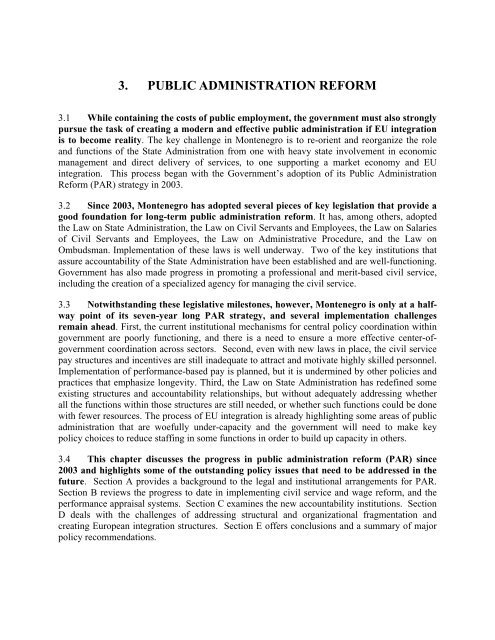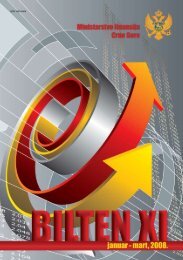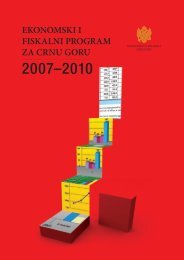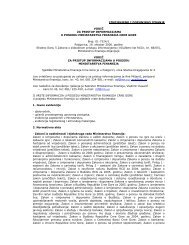Republic of Montenegro: Public Expenditure and ... - Vlada Crne Gore
Republic of Montenegro: Public Expenditure and ... - Vlada Crne Gore
Republic of Montenegro: Public Expenditure and ... - Vlada Crne Gore
Create successful ePaper yourself
Turn your PDF publications into a flip-book with our unique Google optimized e-Paper software.
3. PUBLIC ADMINISTRATION REFORM<br />
3.1 While containing the costs <strong>of</strong> public employment, the government must also strongly<br />
pursue the task <strong>of</strong> creating a modern <strong>and</strong> effective public administration if EU integration<br />
is to become reality. The key challenge in <strong>Montenegro</strong> is to re-orient <strong>and</strong> reorganize the role<br />
<strong>and</strong> functions <strong>of</strong> the State Administration from one with heavy state involvement in economic<br />
management <strong>and</strong> direct delivery <strong>of</strong> services, to one supporting a market economy <strong>and</strong> EU<br />
integration. This process began with the Government’s adoption <strong>of</strong> its <strong>Public</strong> Administration<br />
Reform (PAR) strategy in 2003.<br />
3.2 Since 2003, <strong>Montenegro</strong> has adopted several pieces <strong>of</strong> key legislation that provide a<br />
good foundation for long-term public administration reform. It has, among others, adopted<br />
the Law on State Administration, the Law on Civil Servants <strong>and</strong> Employees, the Law on Salaries<br />
<strong>of</strong> Civil Servants <strong>and</strong> Employees, the Law on Administrative Procedure, <strong>and</strong> the Law on<br />
Ombudsman. Implementation <strong>of</strong> these laws is well underway. Two <strong>of</strong> the key institutions that<br />
assure accountability <strong>of</strong> the State Administration have been established <strong>and</strong> are well-functioning.<br />
Government has also made progress in promoting a pr<strong>of</strong>essional <strong>and</strong> merit-based civil service,<br />
including the creation <strong>of</strong> a specialized agency for managing the civil service.<br />
3.3 Notwithst<strong>and</strong>ing these legislative milestones, however, <strong>Montenegro</strong> is only at a halfway<br />
point <strong>of</strong> its seven-year long PAR strategy, <strong>and</strong> several implementation challenges<br />
remain ahead. First, the current institutional mechanisms for central policy coordination within<br />
government are poorly functioning, <strong>and</strong> there is a need to ensure a more effective center-<strong>of</strong>government<br />
coordination across sectors. Second, even with new laws in place, the civil service<br />
pay structures <strong>and</strong> incentives are still inadequate to attract <strong>and</strong> motivate highly skilled personnel.<br />
Implementation <strong>of</strong> performance-based pay is planned, but it is undermined by other policies <strong>and</strong><br />
practices that emphasize longevity. Third, the Law on State Administration has redefined some<br />
existing structures <strong>and</strong> accountability relationships, but without adequately addressing whether<br />
all the functions within those structures are still needed, or whether such functions could be done<br />
with fewer resources. The process <strong>of</strong> EU integration is already highlighting some areas <strong>of</strong> public<br />
administration that are woefully under-capacity <strong>and</strong> the government will need to make key<br />
policy choices to reduce staffing in some functions in order to build up capacity in others.<br />
3.4 This chapter discusses the progress in public administration reform (PAR) since<br />
2003 <strong>and</strong> highlights some <strong>of</strong> the outst<strong>and</strong>ing policy issues that need to be addressed in the<br />
future. Section A provides a background to the legal <strong>and</strong> institutional arrangements for PAR.<br />
Section B reviews the progress to date in implementing civil service <strong>and</strong> wage reform, <strong>and</strong> the<br />
performance appraisal systems. Section C examines the new accountability institutions. Section<br />
D deals with the challenges <strong>of</strong> addressing structural <strong>and</strong> organizational fragmentation <strong>and</strong><br />
creating European integration structures. Section E <strong>of</strong>fers conclusions <strong>and</strong> a summary <strong>of</strong> major<br />
policy recommendations.
















